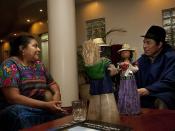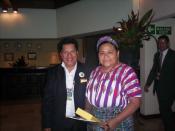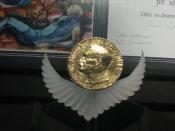Rigoberta Menchú, a Guatemalan human rights activist who won the Nobel Peace Prize in 1992. Despite her youth she became a powerful spokesperson focusing on the promotion of the defence of human rights, peace, and Indigenous Peoples' rights for the entire Western Hemisphere. Like the Che Guevara legend, the imagery surrounding Rigoberta Menchú served the ideological needs of the urban left. According to Rigoberta Menchú, the Indians are good; the ladinos (Guatemalans who reject Indian values of Mayan origin) are bad. Her extreme polarity is the result of mistreatment by the ladinos she has worked for or encountered in her life. "In Guatemala," she says, "the division between Indians and ladinos has contributed to our situation".As an Indianist, she desires separation, but she has come to realize that unification is the only way to end repression.
Rigoberta Menchú Tum was born on January 9, 1959, in the small village of Chimel, near San Miguel de Uspantán, the capital of the north-western province of El Quiché, in Guatemala.
Her mother, Juan Tum Cotoja, was a midwife and traditional leader, and her father, Vincente, was a day labourer, catechist, and community leader. Both her parents belonged to one of the many indigenous groups of Guatemala, the Quiché Maya, and spoke very little Spanish. Young Menchú herself only spoke Quiché (one of over twenty different languages spoken in her country) until she was 19. The land her family lived on was first claimed and cultivated by Rigoberta's parents in the 1960s as they moved, leaving their old community, due to ladinos gradually taking over. Other indigenous came soon thereafter, and they formed a community, which began to see productive harvests some eight years after they first began farming.
However, the small plot of land that her family owned did not produce enough to...


